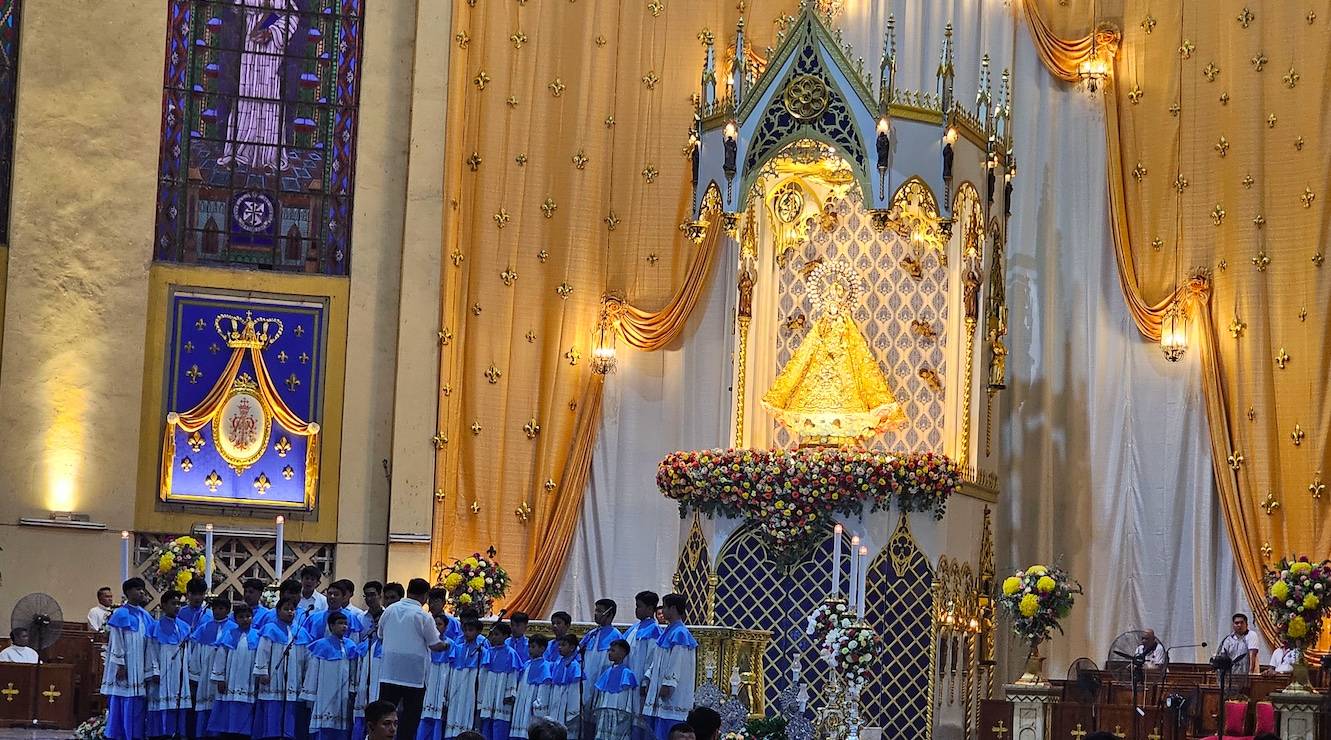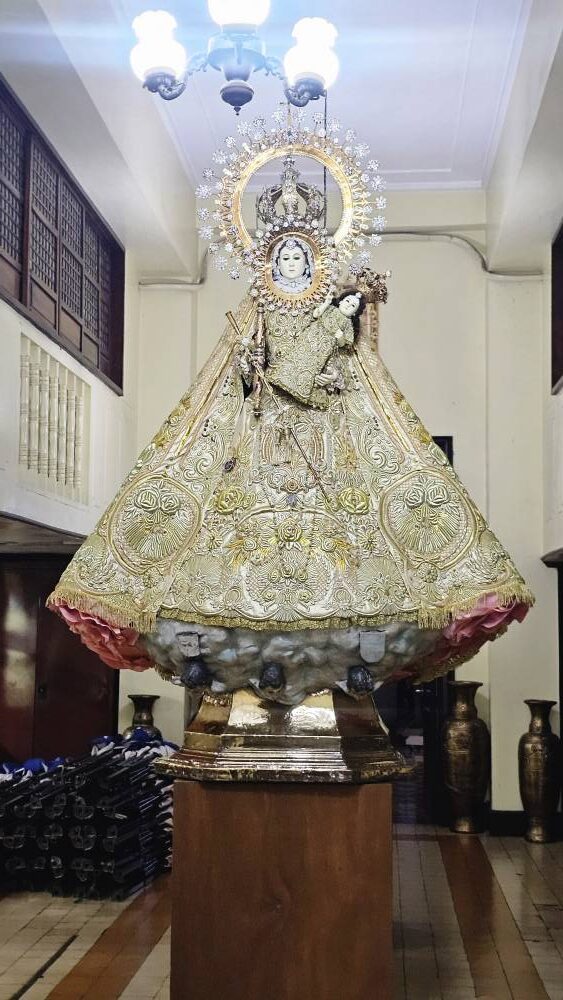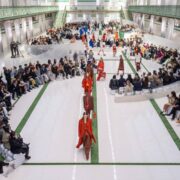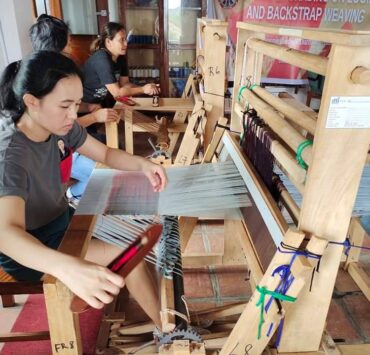A young La Naval devotee’s story

Here in the Philippines, the Virgin Mary has various titles such as the Immaculate Conception, Mother of Perpetual Help, Our Lady of Manaoag, of Antipolo, of Peñafrancia. Also among these titles is Our Lady of the Holy Rosary, or La Naval de Manila, widely known as the “Birhen ng La Naval.”
In 1593, the new Spanish governor general Don Luis Pérez Dasmariñas commissioned a statue of Our Lady of the Rosary to honor his dead father. The sculpture was made by a Chinese immigrant and was given to Dominican friars who installed it at the Santo Domingo Church.
In 1646, the Dutch Republic tried to conquer the Philippines and Spanish and Filipino forces united to stop it from happening. They were said to have requested the intercession of the Virgin through the statue prior to battle, and vowed special homage to Our Lady of the Rosary after victory.
After five major battles at sea, the Dutch finally gave up. Fulfilling their vow and showing their gratitude to the Virgin, the survivors walked barefoot to the shrine.
The cathedral chapter of the Archdiocese of Manila declared the victorious battles miraculous, and attributed them to the intercession of the Virgin.
Journey
Since then, devotees have celebrated the feast of Our Lady of La Naval every second Sunday of October.
In a 2004 article for the Boletin Eclesiastico de Filipinas, Rev. Fr. Pedro Tejero O.P. wrote about the journey of the venerated image of La Naval from Intramuros to its current shrine at Santo Domingo Church. According to Tejero, the image of the Virgin of La Naval had historically been kept at the original Santo Domingo Church, which was founded in 1587 inside Intramuros. The church drew people for the yearly La Naval and Good Friday processions, two major celebrations for the faithful.

But things changed when the World War II began in 1941. A squadron of Japanese airplanes bombarded the city of Manila, including Santo Domingo Church. Priests had hidden the image in a vault called the Procuracion de la Provincia del Santo Rosario as a safety measure against the “worst possible scenario.” Three days later, they returned to the vault and retrieved the image of the Virgin.
It was then transferred to the chapel of the University of Santo Tomas until it was moved again to the new church of Santo Domingo on Oct. 10, 1954. Fr. Tejero wrote, “At four o’ clock in the afternoon, around one million faithful had gathered to join and watch the procession. The Virgin, enthroned on a soberly adorned carroza, traveled from the chapel of the UST to Santo Domingo church.”
Tejero also wrote about the different groups devoted to the Virgin of La Naval, including the Rosary Confraternity which continues its practices.
Enthronement
Last Oct. 3, the enthronement of Our Lady of La Naval was held, marking the beginning of the La Naval celebrations for 2024. A motorcade made stops at various schools and centers such as Siena College, St. Theresa’s College, UST Angelicum College, Philippine Orthopedic Center and Fe Del Mundo Medical Center.
At each stop, devotees both young and old offered prayers to the Virgin and were sprinkled with holy water by the priests. At 5 p.m., the enthronement started. I was blessed to attend right after my classes, since my school is right next to the shrine.
I headed to the convent area of the Sto. Domingo church to get some holy water. There were volunteers and security guards at the doors and I asked for permission to go in quickly to get some holy water. I took a peek and saw the image of Our Lady of the Rosary-La Naval de Manila. I felt joy and amazement seeing just how close I was to her splendor.
Milestones
I grew up as a devotee of Our Lady of La Naval, partly due to my school, UST Angelicum College, being located next to the Santo Domingo Church. The school is owned by the Dominicans. Various milestones in my life were held at the Santo Domingo Church, under the gaze of the Virgin. My first Holy Communion, confirmation and moving-up ceremony took place inside the church.
More than that, my devotion in praying the rosary was fueled by our school’s environment of being active in the faith. We pray the rosary daily during the month of October.
I took part in my first La Naval procession last year. UST Angelicum has made it a tradition for its students to join the procession. Although I was not required, I chose to join my friends who also wished to experience it.
It touched my soul to see flocks of people praying the rosary as we walked the streets. Various devotees came as part of their vow, or panata, for miracles which they received.
I was also fulfilling a vow—I was there to give thanks for the recovery of my mother after a surgery.
The rites began with a recitation of the rosary, followed by Dominican Litany to the Blessed Virgin Mary. The faithful sang “Salve Regina,” the Latin version of the “Hail Holy Queen” prayer. As the Virgin was being raised, the Tiples de Santo Domingo and the Dominican brothers serenaded her and the crowd with the hymns “Bendita Sea Tu Pureza” and “Regina Sacratissimi Rosarii.”
The Blessed Virgin of La Naval is a mother and aid to all. She is celebrated as the Patroness of Quezon City, as declared back in 1973. But for me, she is a patroness for all who seek peace. The blessed Mother of La Naval does not turn down anyone who calls, for her main goal is to lead all to Christ, the peace of our hearts. She obtains various favors to show us the love of the Lord. And this reflects her love as a mother to us all. Viva la Virgen de La Naval!

















